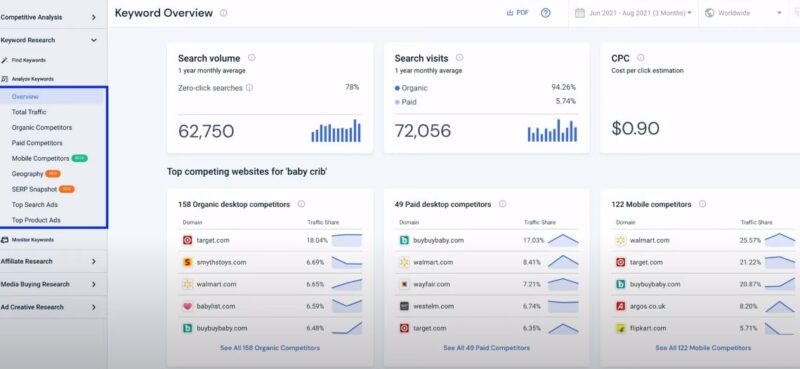PPC (Pay-Per-Click) advertising is crucial for startups aiming to achieve high ROI and visibility quickly.
Unlike organic strategies, PPC ensures immediate exposure, driving traffic and potential conversions quickly.
For startups, every dollar counts, and PPC’s ability to target specific demographics with precision means more efficient budget allocation.
Being aware of competitors’ strategies through PPC analysis can uncover market gaps, enabling startups to exploit these opportunities and stay ahead.
Table of Contents
TogglePPC Competitor Analysis
PPC competitor analysis involves systematically studying your competitors’ PPC strategies to understand:
- Strengths
- Weaknesses
- Market positions
The primary objectives are to gain insights into competitors’ tactics, identify market opportunities, and refine your own campaigns for better performance.
Through analysis, startups can learn which keywords are most effective, what kind of ad copy resonates with the audience, and which landing page elements drive conversions.
Benefits of PPC Competitor Analysis
Conducting a PPC competitor analysis offers several benefits.
- First, it provides competitive insights, allowing startups to understand what is working well for their rivals and what is not.
- Secondly, it aids in budget optimization by highlighting which keywords and strategies offer the best return on investment.
- Finally, it enhances overall campaign performance by providing a clear picture of the competitive landscape.
Identifying Your Competitors
Competitors can be categorized into:
- Direct
- Indirect
- Affiliates
- Resellers
Direct competitors offer the same products or services, while indirect provide alternatives that meet the same needs.
Affiliates and marketing partners promote your competitors’ products, and resellers distribute them.
Identifying these competitors is crucial for comprehensive PPC analysis.
Certain tools are invaluable for this task, tools like:
The reason they are so useful is they provide detailed insights into who your competitors are and how they are performing in the PPC landscape.
Google Ads Auction Insights provides data on which are bidding on the same keywords as you.
SEMrush offers comprehensive competitive analysis features, including keyword and ad copy analysis.
SpyFu reveals competitors’ top-performing keywords and ad variations, while Ahrefs focuses on backlink and keyword strategies.
Analyzing Competitors’ PPC Strategies

Keyword research is foundational in analyzing competitors’ PPC strategies. Startups must identify which keywords their prioritize and how they rank for these terms.
Understanding where competitors place their ads and their performance metrics, such as impression share and overlap rate, provides deeper insights.
Tools like Similarweb and SpyFu can track ad placements, helping startups understand competitors’ ad strategies and optimize their own for better placement and performance.
Ad Placement and Performance
Analyzing where competitors place their ads and how these ads perform is crucial for optimizing your own PPC strategy.
Metrics like impression share, overlap rate, and position above rate offer insights into competitors’ visibility and performance.
The analysis helps in understanding the effectiveness of different ad placements and refining your strategies to achieve better visibility and higher conversion rates.
Evaluating Competitors’ Ad Copy and Landing Pages

Ad copy analysis involves examining the key elements of competitors’ ads, such as:
- Keywords
- Tone
- Calls-to-action (CTAs)
- Visuals
A cohesive landing page experience is equally important.
Using the AIDA framework—Attention, Interest, Desire, Action—startups can evaluate the effectiveness of landing pages in terms of design, user experience, and conversion elements, ensuring their own landing pages are optimized for maximum impact.
Evaluating landing pages is critical for understanding their conversion strategies.
A good landing page captures attention, generates interest, creates desire, and prompts action (AIDA framework).
Assessing design elements, user experience, and conversion components can provide insights into what works and what doesn’t.
Competitors’ Target Audience

Identifying competitors’ target demographics and behaviors is essential for tailoring your own PPC campaigns.
Knowing all about the demographics enables startups to identify underserved segments and tailor their campaigns accordingly.
Demographic and behavioral analysis helps startups understand who their competitors are targeting and how.
It involves examining:
- Age
- Gender
- Location
- Interests
- Online behaviors
By identifying gaps in competitors’ targeting, startups can discover new opportunities.
Tailoring PPC campaigns to address these gaps can lead to better engagement and higher conversion rates, as they resonate more effectively with the intended audience.
Competitor Budget and Spend Analysis
Analyzing competitors’ ad spend is crucial for understanding their PPC strategies and performance.
By correlating ad spend with visibility and performance, startups can identify which strategies are most cost-effective.
This analysis helps in optimizing their own ad spend, ensuring that every dollar invested yields the highest possible return.
Strategies for Optimizing Ad Spend
Optimizing ad spend involves strategic allocation of your PPC budget based on insights gained from competitor analysis.
Start by identifying high-performing keywords and ad placements.
Allocate more budget to these areas while reducing spend on underperforming ones.
Regularly review and adjust your budget based on performance metrics like:
- CPC
- CTR
- Conversion rates
Tracking Competitor Performance and ROI
Monitoring key metrics such as average positions, CPC, CTR, and conversion rates is essential for evaluating competitors’ performance.
Estimating competitors’ ROI involves analyzing their ad spend and performance data.
This ongoing tracking ensures that startups remain competitive and can adapt their strategies as needed.
Key metrics to monitor in competitor PPC analysis include average ad positions, cost-per-click (CPC), click-through rate (CTR), and conversion rates.
These metrics provide insights into competitors’ ad performance and effectiveness.
Regularly monitoring these metrics enables startups to make data-driven decisions, optimize their campaigns, and stay ahead in the competitive landscape.
Summary
PPC competitor analysis is a vital component for startups looking to maximize their ROI and gain a competitive edge in the digital landscape.
You can effectively allocate your budget and enhance your overall PPC performance.
Implementing a comprehensive analysis strategy and leveraging advanced tools and techniques will ensure continuous improvement and adaptation, keeping your startup ahead in the competitive PPC arena.
Related Posts:
- What Is One Way to Begin Saving Startup Capital?…
- Startup's Guide to Venture Capital Funding - How To…
- From Idea to Prototype - A Step-by-Step Guide
- Building a PR Team - A Startup's Guide to PR Management
- Step-by-Step Explanation of Direct vs. Indirect…
- First Time Logging into Gimkit - A Guide for Beginners









